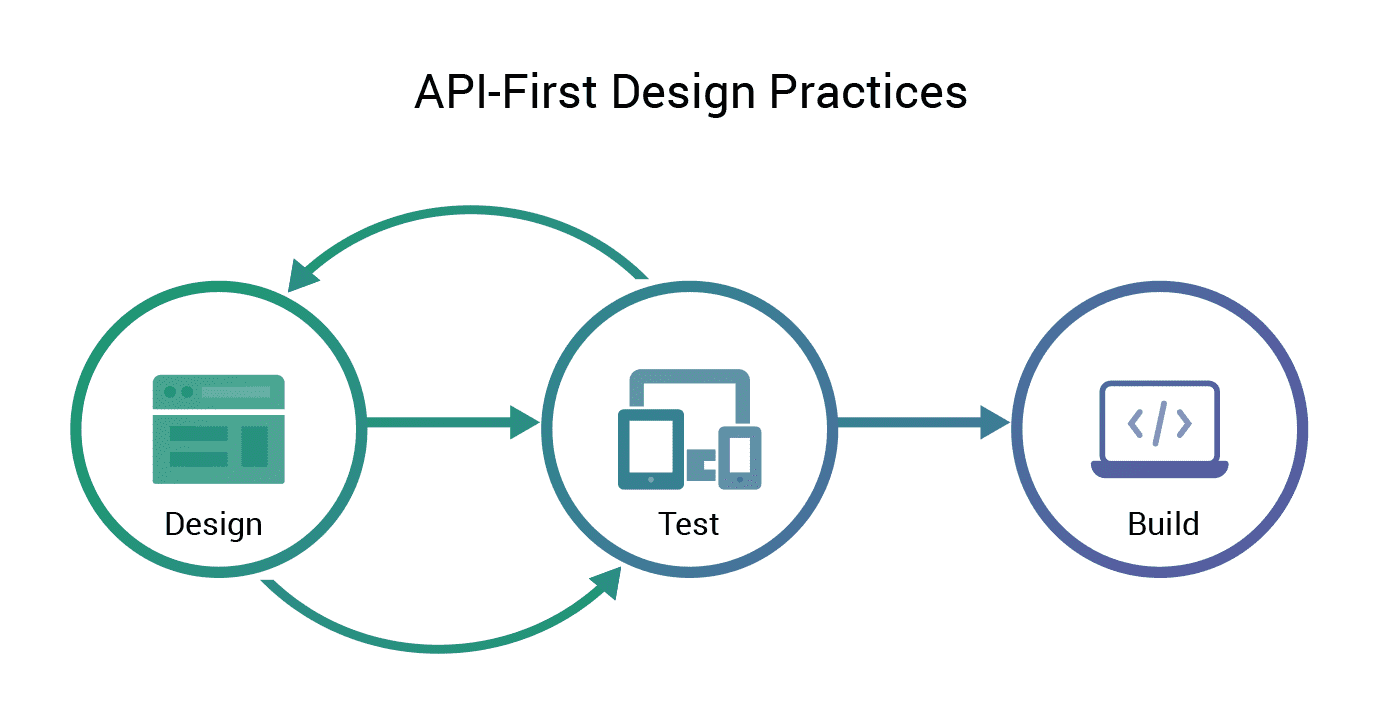API-First Design is a strategic approach that brings numerous advantages to businesses embracing digital transformation. Organizations can unlock a range of benefits by prioritizing APIs at the beginning of the software development process and designing them before writing any code. This design-first mindset ensures that APIs are treated as products and involves all stakeholders, resulting in improved developer experience, increased efficiency and cost savings, enhanced API security, streamlined internal workflows, and opportunities for innovation and growth.
APIs, or application programming interfaces, allow for communication between different software. Thousands of programs use APIs throughout the digital ecosystem and are becoming an essential method of connecting legacy systems and other programs to create more efficient processes.
Traditional software design focuses on the user experience because no one wants to use an unfriendly system, whether an end user or a developer. But when APIs are created after a system is designed, it is beholden to its constraints and idiosyncrasies.
By developing with an API-First Design methodology, APIs are more than just a byproduct of an internal system. API-First Design establishes a contract for how your API communicates with other programs, even if the language behind a program is unknown.

What is API-first?
API-first design is an approach to software development in which the application programming interfaces (APIs) are designed and specified first before any application coding begins. This is a shift from the traditional approach where coding the application logic starts before or in tandem with API development.
Understanding API-First Design Principles
API-First Design principles lay the foundation for successful integration by prioritizing the design and development of APIs as products. This design approach involves treating APIs as the core building blocks of software development, with the API design process taking precedence over writing code. By adopting an API-First philosophy, businesses can create robust and scalable APIs that cater to the needs of developers and end-users, ensuring a seamless and efficient integration process.
When businesses embrace API-First Design, they shift their focus from code-centric development to a design-first approach. This allows them to carefully plan and architect their APIs, leading to improved connectivity, streamlined workflows, and enhanced collaboration among internal teams. By involving all stakeholders from the beginning, including developers, architects, and business analysts, API-First Design ensures that each party's requirements are considered, resulting in APIs that meet their specific needs.
Implementing API-First Design best practices involves several key steps. First, businesses need to identify clear use cases and define the functionality and behavior of their APIs. This consists in understanding end-user's needs and determining how the APIs will interact with other systems or services. Next, businesses should design consistent and intuitive APIs that follow industry standards and strive for simplicity. By prioritizing ease of use, companies can enhance the developer experience and encourage the adoption of their APIs.
Adopting an API-First Design approach provides numerous benefits to businesses. By designing APIs as products, companies can foster innovation and drive growth by enabling experimentation and collaboration. The iterative nature of API-First Design allows companies to receive feedback early in the development process, facilitating continuous improvement and the creation of high-quality APIs.
Moreover, API-First Design promotes efficiency and cost savings by reducing rework and ensuring that the APIs are designed with scalability and reusability. This saves time and enables businesses to adapt to changing market demands and scale their operations effectively.
Benefits of API-First Design:
- Development teams can work in parallel: Different groups can work on all sides of an API simultaneously without wasting time or money by waiting for application updates. This allows developers to mock APIs and effectively test any relevant dependencies. This can lead to an increase in productivity and efficiency.
- Lower development cost: Using an API-First Methodology allows for the recycling of code between projects so development teams always have a baseline architecture to work with. This also reduces associated time and financial costs resulting from starting from scratch. Developers can troubleshoot API issues sooner and often without any code, which leads to smoother integrations.
- Increase speed to market: With automation, much of the API construction process can be sped up. This also allows even novice developers to quickly and easily interact with API documentation. With an API-First approach, there's no need to redesign API architecture to add new application product features. This allows for quick release of updates, which has become a consumer expectation.
- Improved developer experience: API-First Design creates an API that is well-designed, well-documented, and consistent, which is essential to a positive developer experience (DX). A positive DX is much desired since developers interact with APIs daily. Because of this, developers can use APIs to easily integrate into other programs, quickly troubleshoot issues, and even onboard other developers in less time.
- Reduced risk of failure: APIs have become integral to the operational landscape, interacting with everything from marketing and sales to consumer-facing applications representing the brand. Losses in any area can be devastating. With API-First Design, error risk is significantly reduced due to inherent reliability, stability, and consistency of design and implementation.
The Core Pillars of API-First Design
API-First Design is built upon solid API architecture and an overarching strategy that prioritizes the API as the foundation of digital transformation. By focusing on API design from the outset, businesses can create a robust and scalable ecosystem that enables seamless connectivity and drives innovation. Three key pillars underpin the success of API-First Design: clarity, consistency, and collaboration.
Clarity
Clarity refers to the clarity of purpose and functionality that APIs provide. Well-designed APIs clearly define their purpose, making it easier for developers to understand and utilize their capabilities. By following consistent naming conventions, providing comprehensive documentation, and adopting industry standards, businesses can ensure that their APIs are intuitive and easy to integrate.
Consistency
Consistency is crucial in API-First Design as it facilitates interoperability and reduces development time. By adhering to a consistent design pattern and API style guide, businesses can ensure that their APIs are predictable and easy to use. Consistency also extends to versioning and deprecation strategies, allowing seamless transitions and minimizing disruptions to existing integrations.
Collaboration
Collaboration is crucial to the success of API-First Design as it involves involving all stakeholders, such as developers, product managers, and business analysts, in the API design and development process. By fostering collaboration, businesses can ensure that APIs meet the needs of both internal teams and external partners. Additionally, involving stakeholders from different disciplines can lead to innovative ideas and solutions that drive business growth.
Businesses can establish a solid foundation for their API ecosystem by focusing on these pillars. This approach allows for scalability, adaptability, and agility, enabling organizations to respond to changing market demands and drive digital transformation. Embracing API-First Design is essential for businesses seeking to leverage the power of APIs and unlock their full potential in the digital age.
Connecting and communicating with others is a massive part of the internet; use APIs to your advantage. Moreover, the above makes a strong case for planning your web development around your API integrations.
API First vs. Code First
API first and code first are two different approaches to building APIs and integrating them with database/persistence layers:
API First
- Design and define the APIs first (endpoints, request/response schemas, etc), typically in a language-agnostic format like OpenAPI/Swagger.
- Generate code stubs and boilerplate from the API definitions for various frameworks and languages.
- Implement business logic and persistence/database code to connect the APIs.
Benefits:
- API contract is well documented upfront.
- The front end and back end can start in parallel.
- Easy to onboard new developers.
Code First
- Write code for the persistence layer and data models first (entity framework in .NET for example).
- Expose the data and business logic as API endpoints.
- Add API documentation optionally.
Benefits:
- Great for rapid prototyping, less design up front.
- Changes to data models and business logic are automatically reflected in APIs.
In summary, API first is more design-driven, with an emphasis on planning, documentation, and contract first. Code first does less upfront design and is better suited when requirements change often during development. Most real-world projects take a pragmatic hybrid approach, choosing what works best for the system under development.
Conclusion: Embracing API-First Design for Success
Embracing APi-first design is critical to unlocking the full potential of digital transformation and enabling businesses to thrive in a rapidly evolving digital landscape. Companies can reap numerous benefits by prioritizing APIs at the beginning of the software development process and designing the API before writing any code.
One of the critical advantages of API-First Design is the improved developer experience it offers. By treating APIs as products and involving all stakeholders in the design process, businesses can create intuitive and scalable APIs that cater to the needs of developers and end-users. This, in turn, increases efficiency and streamlines development processes, fostering collaboration among internal teams.
Moreover, API-First Design enables businesses to save costs by reducing redundant development efforts and enabling seamless integrations with external systems. It also enhances API security by considering security measures from the outset and implementing robust authentication and authorization mechanisms.
Furthermore, by adopting an API-centric approach, businesses can drive innovation and growth. API-First Design provides opportunities for experimentation and collaboration, allowing companies to unlock new revenue streams, expand their reach, and stay ahead of the competition. It establishes a solid foundation for digital initiatives, optimizing efficiency and providing seamless experiences for users and developers alike.












